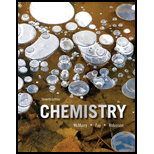
Interpretation:
In the following reaction of formation of carbon monoxide. 1.50 mole of CO2and excess of solid are heated in a container having volume 20.0 L at 1100 K temperature and the equilibrium concentration of CO is 7.00M. Find out:
- Equilibrium concentration of CO2
- The value of equilibrium constant at 1100 K temperature.
Concept introduction:
Equilibrium is the process in which temperature, pressure, concentration of reactant and product do not show any change with respect to time.
There are two types of equilibrium.
- Physical equilibrium: In this, the physical state of the reactant and the product does not change when dynamic equilibrium occurred.
Chemical equilibrium : In this, the chemical composition of reactant and product does not change when dynamic equilibrium occurred. There are two types of reaction occurred in this.
(a) Reversible reactions: In this reaction, reaction can occur in two ways where reactant can convert to product as well as product can convert back to reactant.
(b) Irreversible reaction: In this reaction, reaction cannot occur in two ways where reactant can convert to product, but product cannot convert back to reactant.
Equilibrium constant
Reaction quotient Q is defined as the ratio at any point of the reaction of the concentration of the product raised to the power of their stoichiometric coefficients and reactant raised to the power of their stoichiometric coefficients.
To calculate:
The value of equilibrium constant and equilibrium concentration of the reaction of formation of carbon monoxide.
Trending nowThis is a popular solution!

Chapter 14 Solutions
Chemistry (7th Edition)
 ChemistryChemistryISBN:9781305957404Author:Steven S. Zumdahl, Susan A. Zumdahl, Donald J. DeCostePublisher:Cengage Learning
ChemistryChemistryISBN:9781305957404Author:Steven S. Zumdahl, Susan A. Zumdahl, Donald J. DeCostePublisher:Cengage Learning ChemistryChemistryISBN:9781259911156Author:Raymond Chang Dr., Jason Overby ProfessorPublisher:McGraw-Hill Education
ChemistryChemistryISBN:9781259911156Author:Raymond Chang Dr., Jason Overby ProfessorPublisher:McGraw-Hill Education Principles of Instrumental AnalysisChemistryISBN:9781305577213Author:Douglas A. Skoog, F. James Holler, Stanley R. CrouchPublisher:Cengage Learning
Principles of Instrumental AnalysisChemistryISBN:9781305577213Author:Douglas A. Skoog, F. James Holler, Stanley R. CrouchPublisher:Cengage Learning Organic ChemistryChemistryISBN:9780078021558Author:Janice Gorzynski Smith Dr.Publisher:McGraw-Hill Education
Organic ChemistryChemistryISBN:9780078021558Author:Janice Gorzynski Smith Dr.Publisher:McGraw-Hill Education Chemistry: Principles and ReactionsChemistryISBN:9781305079373Author:William L. Masterton, Cecile N. HurleyPublisher:Cengage Learning
Chemistry: Principles and ReactionsChemistryISBN:9781305079373Author:William L. Masterton, Cecile N. HurleyPublisher:Cengage Learning Elementary Principles of Chemical Processes, Bind...ChemistryISBN:9781118431221Author:Richard M. Felder, Ronald W. Rousseau, Lisa G. BullardPublisher:WILEY
Elementary Principles of Chemical Processes, Bind...ChemistryISBN:9781118431221Author:Richard M. Felder, Ronald W. Rousseau, Lisa G. BullardPublisher:WILEY





